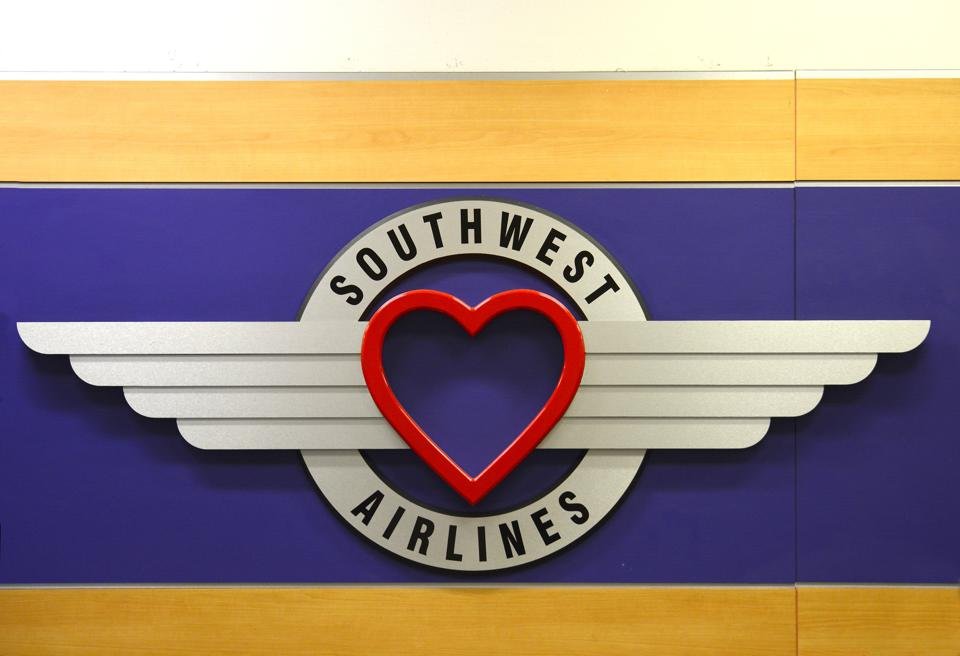
SALT LAKE CITY, UT – SEPTEMBER 28, 2014: The Southwest Airlines logo on the wall behind the … [+]
The shares of Southwest Airlines (NYSE: LUV) have rallied 20% in the past 21-days reaching their pre-Covid level, propelled by the second round of payroll support by the U.S. government and an increase in passenger numbers at TSA checkpoints. Interestingly, Southwest is a prominent Boeing 737 MAX customer with a total of 380 aircraft to be delivered in the next couple of years. Despite the lifting of the FAA’s ban in November 2020, the shares of Boeing (NYSE: BA) remain around 30% below pre-Covid levels. While the FAA’s order requires design changes and revamp of pilot and crew training programs to safely fly again, the company’s ballooning debt due to high inventory levels is expected to ease with aircraft deliveries. Trefis compares the historical stock price trends between Boeing and its prominent MAX customers in an interactive dashboard analysis, BA Stock Has 50% Chance Of A Rise Over The Next Month After Rising 4.3% In The Last 5 Days.
Airline stocks have outperformed broader markets this year but Boeing has not
In a recently published travel outlook by Expedia, air travel is expected to boom later during the year with young population (Millennials and Gen Z) traveling the most. Over the past 21 days, Southwest Airlines, United Airlines, and American Airlines’ stocks have gained 20%, 27%, and 25%, respectively. On the contrary, Boeing stock has increased by 12%, 10%, and 4% over the twenty one-day, ten-day, and five-day period respectively. Per Boeing’s commercial market outlook, global passenger traffic and aircraft fleet are expected to grow annually by 4% and 3.2% in the next twenty years, respectively. Also, new aircraft demand will mostly be driven by older aircraft replacements, almost 56% of new deliveries, in the coming decade.
Boeing’s debt is due to high inventory levels
Boeing’s long-term debt soared from $10 billion in 2018 to $62 billion in 2020, due to piled-up 737 MAX inventories and capital raises to tackle any adverse pandemic scenario. The company’s inventories observed a $20 billion jump from $62.5 billion in 2018 to $82 billion in 2020. As the balance sheet holds $25 billion of cash and short-term investments, a major portion of the long-term debt is due to high inventory levels.
While the 737 MAX production is expected to resume later this year, the 450 planes in the warehouse are likely to meet near-term customer demand and generate cash flow. Also, Boeing reported just $7.5 billion of operating cash outflow (excluding the impact of an $11 billion increase in inventories) in 2020, which is significantly lower than the $55 billion drop in the stock’s market capitalization. Thus, the resumption of MAX production is the key trigger for a sizable upside in Boeing stock from current levels.
As the slump in travel demand continues to weigh on the aviation sector, 2020 has created many pricing discontinuities which can offer attractive trading opportunities. For example, you’ll be surprised how the stock valuation for Expeditors International vs. LGI Homes shows a disconnect with their relative operational growth. You can find many such discontinuous pairs here.
See all Trefis Price Estimates and Download Trefis Data here
What’s behind Trefis? See How It’s Powering New Collaboration and What-Ifs For CFOs and Finance Teams | Product, R&D, and Marketing Teams
























